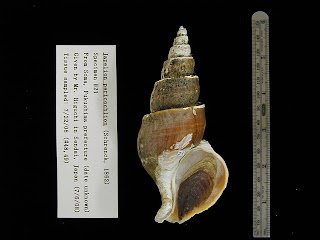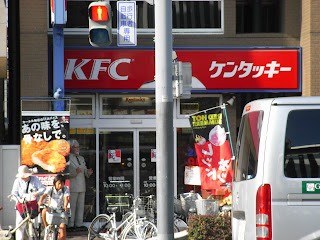This is Babylonia japonica. Historically, this snail was made into a toy top for Japanese childern by cutting off the apex (pointed coiled part) and filling the whorls with wax. It and the whole Babylonia genus, however, probably do not belong with other tsubu gai. That is, it and its closest relatives are different enough from whelks to be classified into another yet-to-be-determined snail family.
 Buccinum middendorffi is a smallish species that lives from the intertidal zone down to 20 meters off the rocky coast of Northern Japan.
Buccinum middendorffi is a smallish species that lives from the intertidal zone down to 20 meters off the rocky coast of Northern Japan. Neptunea intersculpta is one of many in the genus Neptunea. Sources say that its flesh is delicious!
Neptunea intersculpta is one of many in the genus Neptunea. Sources say that its flesh is delicious! The color variation within Neptunea arthritica cumingii is pronounced as you can see from the following images. It is found in the Japan Sea.
The color variation within Neptunea arthritica cumingii is pronounced as you can see from the following images. It is found in the Japan Sea.

 Neptunea polycostata is a heavy-shelled member of the Neptunea genus and is found in waters off of northern Hokkaido.
Neptunea polycostata is a heavy-shelled member of the Neptunea genus and is found in waters off of northern Hokkaido. Despite its small size, Buccinum tsubai is one of the most commercially important whelks in Japan.
Despite its small size, Buccinum tsubai is one of the most commercially important whelks in Japan. Neptunea constricta has a pretty shell, tasty flesh, and is found from central Honshu to Hokkaido.
Neptunea constricta has a pretty shell, tasty flesh, and is found from central Honshu to Hokkaido. This whelk, Buccinum tenuissimum, holds the impressive title of "the most delicious of all Japanese molluscs" (Kira, 1972).
This whelk, Buccinum tenuissimum, holds the impressive title of "the most delicious of all Japanese molluscs" (Kira, 1972). The brown color on Japelion pericochlion is the pigment of a thin layer of tissue called the periostricum.
The brown color on Japelion pericochlion is the pigment of a thin layer of tissue called the periostricum. On this specimen of Volutharpa ampullacea perryi you can also see the light brown periostricum.
On this specimen of Volutharpa ampullacea perryi you can also see the light brown periostricum.  One other note; if you look closely at the specimen labels you will see the last name of a person after the underlined name of the genus and species. This name indicates the person who described this species and the year that name was published. If the name is not in parentheses it means that the genus name and the species name have not changed since the species name was established by the person named. If the name is in parentheses it means that the genus name has been changed since the species was named. Fun with taxonomy and systematics!
One other note; if you look closely at the specimen labels you will see the last name of a person after the underlined name of the genus and species. This name indicates the person who described this species and the year that name was published. If the name is not in parentheses it means that the genus name and the species name have not changed since the species name was established by the person named. If the name is in parentheses it means that the genus name has been changed since the species was named. Fun with taxonomy and systematics!











































